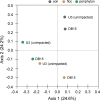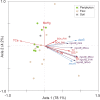Periphyton and Flocculent Materials Are Important Ecological Compartments Supporting Abundant and Diverse Mercury Methylator Assemblages in the Florida Everglades
- PMID: 31028023
- PMCID: PMC6581163
- DOI: 10.1128/AEM.00156-19
Periphyton and Flocculent Materials Are Important Ecological Compartments Supporting Abundant and Diverse Mercury Methylator Assemblages in the Florida Everglades
Abstract
Mercury (Hg) methylation in the Florida Everglades is of great environmental concern because of its adverse effects on human and wildlife health through biomagnification in aquatic food webs. Periphyton and flocculant materials (floc) overlaying peat soil are important ecological compartments producing methylmercury (MeHg) in this ecosystem. These compartments retain higher concentrations of MeHg than did soil at study sites across nutrient and/or sulfate gradient(s). To better understand what controls Hg methylation in these compartments, the present study explored the structures and abundances of Hg methylators using genes hgcAB as biomarkers. The hgcA sequences indicated that these compartments hosted a high diversity of Hg methylators, including Deltaproteobacteria, Chloroflexi, Firmicutes, and Methanomicrobia, with community compositions that differed between these habitats. The copy numbers of hgcAB quantified by quantitative PCR revealed that floc and soil supported higher numbers of Hg methylators than periphyton in the Everglades ecosystem. The abundance of Hg methylators was strongly positively correlated with concentrations of carbon and nutrients (e.g., phosphorus and nitrogen) according to redundancy analysis. Strong correlations were also observed among numbers of sulfate reducers, methanogens, and the dominant hgcAB-carrying groups, suggesting that hgcAB would spread primarily through the growth of those assemblages. The abundances of Hg methylators were weakly negatively correlated to MeHg concentrations, suggesting that the size of this population would not solely determine the final concentrations of MeHg in the ecological compartments studied. This study extends the knowledge regarding the distribution of diverse potential mercury methylators in different environmental compartments in a wetland of national concern.IMPORTANCE Methylmercury is a potent neurotoxin that impacts the health of humans and wildlife. Most mercury in wetlands such as the Florida Everglades enters as inorganic mercury via atmospheric deposition, some of which is transformed to the more toxic methylmercury through the activities of anaerobic microorganisms. We investigated the numbers and phylogenetic diversity of hgcAB, genes that are linked to mercury methylation, in the soil, floc, and periphyton in areas of the Everglades with different sulfate and nutrient concentrations. Soil harbored relatively high numbers of cells capable of methylating mercury; however, little detectable methylmercury was present in soil. The greatest concentrations of methylmercury were found in floc and periphyton. The dominant methylators in those compartments included methanogens and Syntrophobacteriales This work provides significant insight into the microbial processes that control methylation and form the basis for accumulation through the food chain in this important environment.
Keywords: flocculent; hgcAB; methylmercury; peat; periphyton; wetlands.
Copyright © 2019 American Society for Microbiology.
Figures





References
-
- Scheidt D, Kalla P. 2007. Everglades ecosystem assessment: water management and quality, eutrophication, mercury contamination, soils and habitat. Monitoring for adaptive management: a R-EMAP status report. USEPA Region 4, Athens, GA.
-
- Pirrone N, Cinnirella S, Feng X, Finkelman RB, Friedli HR, Leaner J, Mason R, Mukherjee AB, Stracher GB, Streets DG, Telmer K. 2010. Global mercury emissions to the atmosphere from anthropogenic and natural sources. Atmos Chem Phys 10:5951−5964. doi:10.5194/acp-10-5951-2010. - DOI
Publication types
MeSH terms
Substances
LinkOut - more resources
Full Text Sources
Molecular Biology Databases

